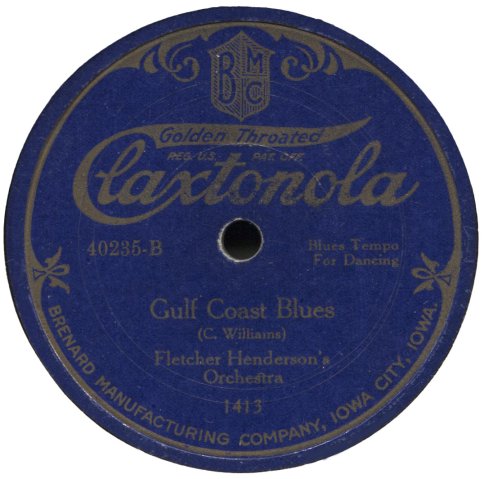
“Gulf Coast Blues”
Fletcher Henderson’s Orchestra
(Claxtonola 40235-B mx 1413) May 1923
“Down Hearted Blues”
Fletcher Henderson’s Orchestra
(Claxtonola 40235-A mx 1406) May 1923
From the Edward Mitchell collection, here are two very jazzy instrumental recordings on a rare label of blues compositions that were also recorded by Bessie Smith and others.
Pianist, bandleader and arranger Fletcher Henderson was an important figure in the 1920s Harlem Renaissance. As an arranger, he significantly influenced the evolution of jazz and popular music. When Benny Goodman came into the national spotlight and launched the swing era in 1935 with his spectacularly successful engagement and broadcasts from the Palomar Ballroom in Los Angeles, he did so on the strength of arrangements that Henerson had written for the band.
Claxtonola records were sold by the Brenard Manufacturing Company of Iowa City, Iowa, owned by James L Records and Theodore O Loveland. The company was founded in 1892 and, by the early 1910s, had become notorious for operating a scam that induced retail merchants such as jewelers and pharmacists to purchase pianos as part of a promotional scheme with an alleged guarantee to increase the merchant’s business. (You can read how the scam worked in this .pdf document of an article from the April 1, 1912 issue of Grocery World And General Merchant.)
In 1918, the company began selling phonographs and records under the brand name Claxtonola, once again as a dubious money-making opportunity targeting small-town merchants.
In exchange for becoming the exclusive Claxtonola “agent” within their town for three years, the merchant agreed to purchase an exorbitantly-priced phonograph through installment payments to be used as a “store display” along with a minimum of twelve records. The merchant also agreed to provide a list of names and addresses of nearby potential prospects the company claimed it would reach out to through its direct marketing and salesforce.
I do not know to what degree merchants purchased records beyond the initial twelve for sale in their stores or to what degree records were sold through contact with the prospects the merchant provided. Regardless, the nature of the scheme undoubtedly contributes to the label’s scarcity today.
Brenard Manufacturing neither manufactured nor recorded the records. All of the label’s recordings come from masters leased from small, independent labels such as Paramount, Gennett, and Black Swan. I have seen information that leads me to suspect that the company contracted with Paramount to press the records, but I am not certain.
The company’s owners were also connected with a label called “National Record Exchange.” This involved a scheme where agents would place ads in their local newspapers promoting ten-cent records through a “record exchange.” Customers would send ten records to the exchange, and for one dollar plus shipping, they would receive ten different records in exchange.
Other than what was described in the local advertisements, I have no information on how the “exchange” worked or how the brand-new records the company issued fit into it. My hunch is that becoming a local agent likely required purchasing a certain minimum of the new records. Records on the National Record Exchange label are even more difficult to find than Claxtonoloa records.
By the late 1920s, Brenard Manufacturing stopped selling phonographs and records but continued with the same scheme to recruit merchants as exclusive local agents for the company’s radios.
When the Federal Trade Commission issued a cease and desist order in 1936 for a lengthy list of deceptive trade practices, the company’s owners had also been operating similar schemes that involved targeting merchants as local agents for the sale of refrigerators, oil burners, and air conditioners. Among that list of deceptive practices was the owners’ companies representing themselves as being “manufacturing companies” when, in fact, they manufactured nothing and merely contracted out to others.
The Claxtonola label featured a variety of musical genres. But many of their issues are of jazz and blues recordings that their original labels had made to market to black record buyers. In some cases, copies on their original labels are also hard to find.
I don’t know if the appearance of such recordings on Claxtonoloa was due to any particular effort by Brenard to target merchants in black communities or if they merely issued whatever masters they could obtain at the lowest possible price.
Both sides on the record here were recorded by Paramount and originally issued on Paramount 20235. But, since Paramount leased its masters to companies besides Brenard, these recordings were also issued on the Grey Gull, Radiex, Puritan, Harmograph, Famous and Oriole labels.
Additionally, since Fletcher Henderson was not bound by an exclusive recording contract, he was free to record under his name for any and all labels. Thus, the following month, he recorded both songs here for Vocalion, which were issued on Vocalion 14636, and he recorded “Gulf Coast Blues” for Columbia, which was issued on Columbia A-3951.
Among the members of Henderson’s band on these recordings was future bandleader Don Redman.
Bessie Smith recorded both songs on February 15, 1923 for her very first record, Columbia A-3844.
“Down Hearted Blues” was composed by Lovie Austin with lyrics by Alberta Hunter, who also recorded it.
“Gulf Coast Blues” was composed by Clarence Williams, who also accompanied Bessie Smith on piano when she recorded it.
– Dismuke
